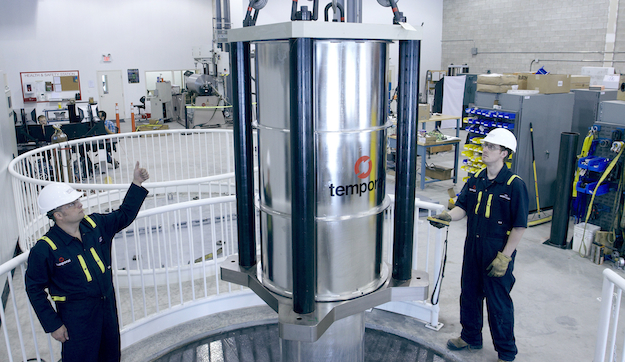Posted at 05:16h
in
Energy
by Shen Ge
What are flywheels?
[caption id="attachment_285" align="aligncenter" width="625"]

A 500 kW flywheel being lowered into the vault at flywheel company Temporal Power’s manufacturing facility to undergo testing (Image: Temporal Power).[/caption]
Lux Research, an independent firm that assesses emerging technologies, predicts that the global energy storage market will grow from a $200 million industry in 2012 to an $11 billion giant by 2017. Chemical batteries have recently made some strides forward and many more companies have jumped on board. However, the most promising way of storing energy for the future might come from a more unlikely source, and one that far predates any battery: the flywheel.
A flywheel is nothing more than a wheel on an axle which stores and regulates energy by spinning continuously. The device is one of humanity’s oldest and most familiar technologies first used in the potter’s wheel 6000 years ago as a stone tablet with enough mass to rotate smoothly between kicks of a foot pedal. Leonardo da Vinci invented one with a variable moment of inertia. It was an essential component in the great machines that brought on the industrial revolution. Today, flywheels are under the hood of every car – regulating the strokes of pistons.
Interested in more of my posts and other writings outside of Impact Hound? Follow me on Twitter:
@shenge86
 A 500 kW flywheel being lowered into the vault at flywheel company Temporal Power’s manufacturing facility to undergo testing (Image: Temporal Power).[/caption]
Lux Research, an independent firm that assesses emerging technologies, predicts that the global energy storage market will grow from a $200 million industry in 2012 to an $11 billion giant by 2017. Chemical batteries have recently made some strides forward and many more companies have jumped on board. However, the most promising way of storing energy for the future might come from a more unlikely source, and one that far predates any battery: the flywheel.
A flywheel is nothing more than a wheel on an axle which stores and regulates energy by spinning continuously. The device is one of humanity’s oldest and most familiar technologies first used in the potter’s wheel 6000 years ago as a stone tablet with enough mass to rotate smoothly between kicks of a foot pedal. Leonardo da Vinci invented one with a variable moment of inertia. It was an essential component in the great machines that brought on the industrial revolution. Today, flywheels are under the hood of every car – regulating the strokes of pistons.
Interested in more of my posts and other writings outside of Impact Hound? Follow me on Twitter: @shenge86
A 500 kW flywheel being lowered into the vault at flywheel company Temporal Power’s manufacturing facility to undergo testing (Image: Temporal Power).[/caption]
Lux Research, an independent firm that assesses emerging technologies, predicts that the global energy storage market will grow from a $200 million industry in 2012 to an $11 billion giant by 2017. Chemical batteries have recently made some strides forward and many more companies have jumped on board. However, the most promising way of storing energy for the future might come from a more unlikely source, and one that far predates any battery: the flywheel.
A flywheel is nothing more than a wheel on an axle which stores and regulates energy by spinning continuously. The device is one of humanity’s oldest and most familiar technologies first used in the potter’s wheel 6000 years ago as a stone tablet with enough mass to rotate smoothly between kicks of a foot pedal. Leonardo da Vinci invented one with a variable moment of inertia. It was an essential component in the great machines that brought on the industrial revolution. Today, flywheels are under the hood of every car – regulating the strokes of pistons.
Interested in more of my posts and other writings outside of Impact Hound? Follow me on Twitter: @shenge86


